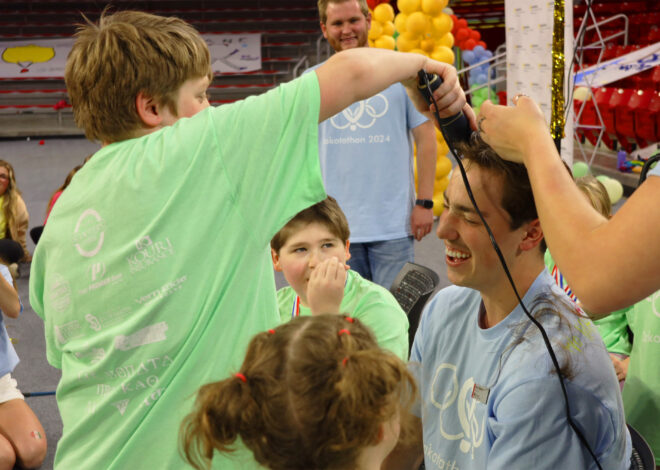
USD community takes part in Breast Cancer Awareness Month
This month, pink represents more than just a color.
From wearing pink gear at an athletic game to organizing fundraisers, students and faculty members are involved in the Breast Cancer Awareness Month mission. People can also help spread awareness when they shop to provide cancer support.
The American Cancer Society estimates there will be more than 252,000 new cases of breast cancer in women in 2017.
Campus outreach
On campus, cancer awareness is promoted by Colleges Against Cancer, a student organization that raises money for the American Cancer Society.
Senior Keri Kamphoff, president of Colleges Against Cancer, said she hopes the events they host will “strike a chord” with people.
“Every person has been affected by cancer in some way,” Kamphoff said. “Whether it be a family member, friend or neighbor, it has touched every person’s life. Therefore, getting involved in this organization gives people the opportunity to honor that person in a way that will one day make a huge difference for anyone that is suffering.”
In the last few years, Colleges Against Cancer has hosted the Clay County Relay for Life, organized pub crawls and volleyball tournaments and planned Fight Back Week.
The group will host Relay for Life and Fight Back Week again this spring.
Kamphoff said Colleges Against Cancer has been successful in its fundraisers in recent years and is looking forward to hosting Relay for Life.
“This is an event that celebrates those who have survived cancer and to honor those who we have lost,” Kamphoff said. “This event is truly special because every person who participates is passionate for this cause and filled with an immense sense of hope that we will be able to make an impact in the war against cancer.”
Earlier this month, Colleges Against Cancer hosted a pub crawl during Dakota Days and raised about $700. They also organized the Big Pink Volleyball Tournament, which raised money for a young girl with cancer who lives in Vermillion.
The group is also collaborating with Vermillion High School’s National Honor Society Chapter to organize a fundraiser.
Kamphoff said planning and organizing fundraisers like these remind her of why she joined Colleges Against Cancer in the first place.
“I am involved in Colleges Against Cancer because I have seen the impact this horrible disease can have,” Kamphoff said. “All of my grandparents and their siblings have suffered from this disease. In addition, I know too many people that have lost their parents due to cancer – I am determined to do all that I can so that no more children have to go through this horrible loss again.”
Athletics
With pink sweatbands, socks or headbands, Breast Cancer Awareness Month is easily recognizable in athletics.
USD student-athletes are supplied with or allowed to wear pink socks, undershirts, jerseys, bows or shoelaces, in addition to their normal uniforms.
In the past, football, volleyball and soccer have had a Pink Day, where athletes and students wear pink to show their support for Breast Cancer Awareness Month. The football team has switched to putting their support more toward the Children’s Miracle Network this year, but volleyball, soccer and basketball all still participate in Pink Day.
Joe Thuente, director of athletic marketing and promotion, said soccer and volleyball have already had their Pink Days. The basketball team will also have a Pink Day this winter, he said.
“Our biggest Pink Day will be in basketball season,” Thuente said. “It’ll involve the players wearing pink jerseys that we’ll auction off after the game and we’ll raise money for breast cancer research.”
Thuente said the athletic aspect of breast cancer awareness has helped increase student involvement.
“Soccer had a Pink Day where the players wore pink jerseys,” Thuente said. “The volleyball players wore pink jerseys and pink socks and raised money online through Facebook and Twitter for their Pink Day as well. We partner with Sanford for Pink Day and Children’s Miracle Network and do a lot of fundraising.”
Research
Along with campus involvement in Breast Cancer Awareness Month, research has also expanded exponentially in the last few decades.
Though breast cancer risks are high, the deaths caused by it have lowered. Because of the progressively increasing awareness and advances in testing and treatments, death rates have been steadily decreasing since 1989 (when screening began in the UK), according to www.breastcancer.org. Women under 50 years old have have experienced even larger decreases because of massive advancements.
Overall, earlier detection screening has played one of the biggest roles in lowering the death rates of breast cancer.
Throughout history, breast cancer has been more common in women than in men.
According to the site, about one in eight U.S. women will develop invasive breast cancer over the course of their lifetimes. Gender and age have a lot to do with one’s risk of breast cancer, but someone can still get breast cancer even if they have no family history of it because of genetic mutations.
It also listed that one in 1,000 men are diagnosed with the disease in their lifetimes.
According to the site, in the total population of the U.S., more than 3.1 million women have experienced breast cancer as of March 2017.
The site said it estimates in 2017, about 30 percent of newly diagnosed cancers will be breast cancer.
Carmen Hammond, executive assistant to the vice president and dean of the USD Sanford School of Medicine, said USD isn’t currently conducting any research on breast cancer.
Dustin VanHunnik also contributed to this article.


